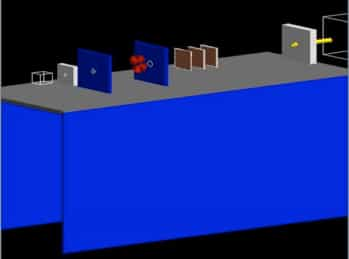Advanced Example Handrontherapy
Responsible Geant4 Collaborator: G.A.P. Cirrone (LNS, INFN, Italy)
Current contributors: G.A.P. Cirrone(a), L. Pandola(a), G. Petringa(a)
Past contributors: R. Calcagno(a), G. Cuttone(a), G. Danielsen (b), F. Di Rosa(a), S. Fattori(a), S. Guatelli(c), A. Heikkinen(b), P. Kaitaniemi(b), A. Lechner(d), S.E. Mazzaglia(a), G. Miluzzo(f), M.G. Pia(e), I. Petrovic(g), J. Pipek(a), A. Ristic-Fira(g), F. Romano(f), G. Russo(a), A. Tramontana(a), A.Varisano(a,f)
(a) Laboratori Nazionali del Sud of INFN, Catania, Italy
(b) Helsinki Institute of Physics, Helsinki, Finland
(c) University of Wollongong, Australia
(d) CERN, Geneve, Switzwerland
(e) INFN Section of Genova, Genova, Italy
(f) INFN Section of Catania, Italy
(g) Vinca Institute for Nuclear Science, Catania, Italy
## Short description Hadrontherapy is a Geant4-based application specifically developed to address typical needs related to proton and ion therapy. The Geant4 example can be used to:
- perform calculations of dose distribution curves in water or other materials,
- derive important transport parameters (stopping powers, ranges, etc.) in different geometrical set-ups and for different materials,
- model a realistic transport beam line for therapy.
The example was released for the first time in 2004. At that time Hadrontherapy was only capable to simulate a well specified proton therapy facility: the passive transport beam line installed at Laboratori Nazionali del Sud (INFN) in Catania, Italy (described below). Today Hadrontontherapy is more flexible and shows many more additional capabilities. For example, it is now possible to simulate also generic proton/ion transport beam lines and to switch among them with a simple user interface. The implemented beam line configurations currently are:
- Passive proton beam line (see Figure 1), which is installed at the LNS-INFN facility in Catania for eye tumor treatment with protons at 62 MeV. It is simulated in PassiveProtonBeamLine.cc;
- Passive carbon beam line, which is the model of the transport beam line at LNS-INFN of Catania for experiments with carbon ion beams.It is simulated in PassiveCarbonBeamLine.cc.
- Energy selector, simulated in EnergySelector.cc; this class describes an energy selector for particle beams produced in a laser-matter interaction, by means of magnetic fields.
For information about how to compile and run the example, the user should refer to the README file, accompanying the example in Geant4.

Description of the passive proton beam line of the Laboratori Nazionali del Sud, Catania, Italy
This beam line is fully modeled in PassiveProtonBeamLine.cc. The main elements are:
- SCATTERING SYSTEM: to transversally enlarge the original beam;
- COLLIMATORS: placed along the beam line to collimate the beam;
- RANGE SHIFTERS: to decrease the energy of the primary proton beam to a specific value;
- MODULATOR WHEEL: to modulate the energy of the primary and mono-energetic beam in to a wide spectrum. The energy modulation is necessary to homogeneously irradiate a tumour volume that can extend in depth up to 20 mm;
- MONITOR CHAMBERS: very thin ionisation chamber that permits the dose monitoring during the patient irradiation;
- MOPI detector: microstrips, air free detector utilised for the check of the beam symmetry during the treatment;
- PATIENT COLLIMATOR: a brass, tumour-shaped collimator able to confine the proton irradiation field in order to irradiate just the tumour mass in the transverse direction;
Last updated: 15/02/2022 by S. Guatelli